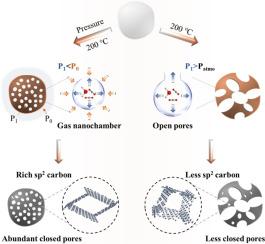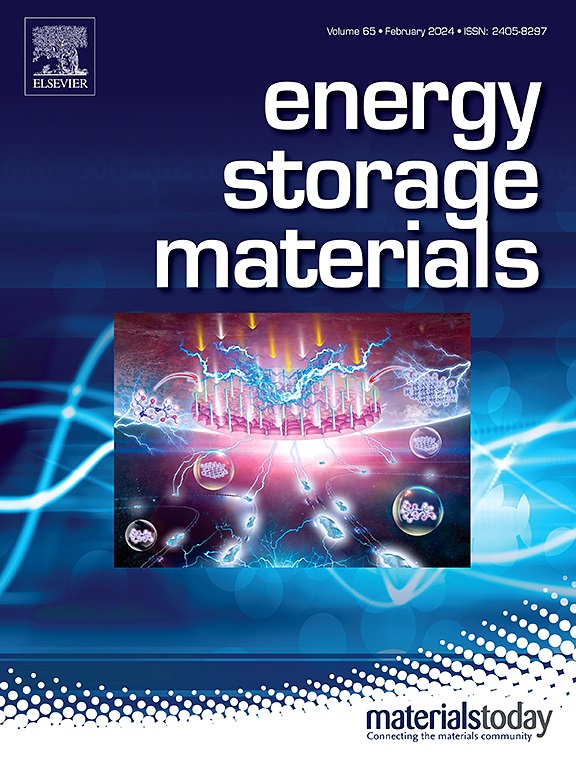预建气体纳米室战略:为钠离子电池生产富含封闭孔隙和 sp2-C 的硬碳
IF 20.2
1区 材料科学
Q1 CHEMISTRY, PHYSICAL
引用次数: 0
摘要
硬碳仍面临着高容量与高初始库仑效率(ICE)不相容的挑战。本文提出了一种预先构建的气体纳米室策略,以生产具有丰富闭孔和sp2-C的硬碳,从而同时实现高容量和ICE。通过平衡碳前驱体热解过程中的自生压力和外部压力,设计了气体纳米室。原位/非原位表征和分子动力学(MD)模拟相结合表明,外部压力可以限制热解气体的强烈释放,从而在大颗粒内形成丰富而均匀的纳米室状封闭孔隙。同时,压力的介入有利于碳原子排列成sp2-C,但存在少量缺陷。体相/界面分析和密度功能理论(DFT)计算的进一步见解表明,这种独特的结构使硬碳能够储存更多的钠离子,并优先分解NaPF6,形成内部富含无机的固体电解质界面(SEI)膜。结果表明,优化后的硬碳具有370.4 mA h g−1的高容量,ICE为89.3%,具有优异的倍率性能和长期循环稳定性,在5.0 a g−1下循环10000次后的容量为136.1 mA h g−1。本文章由计算机程序翻译,如有差异,请以英文原文为准。

Pre-construction Gas Nanochamber Strategy: Producing Hard Carbon Rich in Closed Pores and sp2-C for Sodium-ion Batteries
Hard carbon still faces the challenge of incompatibility between high capacity and high initial Coulombic efficiency (ICE). Herein, a pre-construction gas nanochamber strategy is proposed to produce hard carbon with abundant closed pores and sp2-C, thereby simultaneously achieving high capacity and ICE. The gas nanochambers are engineered by balancing the self-generated pressure and external pressure during the carbon precursor pyrolysis. A combination of in-situ/ex-situ characterizations and molecular dynamics (MD) simulations reveal that the external pressure can restrict the intense release the pyrolyzed gases, thus forming abundant and uniform nanochamber-like close pores within macroparticles. Concurrently, the intervention of pressure facilitates the arrangement of carbon atoms into sp2-C with a few defects. Further insights from bulk phase/interface analysis and density functional theory (DFT) calculations demonstrate that this unique structure enables hard carbon to store more sodium ions and preferentially decompose NaPF6 to form an inner inorganic-rich solid electrolyte interface (SEI) film. As a result, the optimized hard carbon can deliver high capacity of 370.4 mA h g−1 with ICE of 89.3%, excellent rate capability and long-term cycling stability with a capacity of 136.1 mA h g−1 after 10000 cycles at 5.0 A g−1.
求助全文
通过发布文献求助,成功后即可免费获取论文全文。
去求助
来源期刊

Energy Storage Materials
Materials Science-General Materials Science
CiteScore
33.00
自引率
5.90%
发文量
652
审稿时长
27 days
期刊介绍:
Energy Storage Materials is a global interdisciplinary journal dedicated to sharing scientific and technological advancements in materials and devices for advanced energy storage and related energy conversion, such as in metal-O2 batteries. The journal features comprehensive research articles, including full papers and short communications, as well as authoritative feature articles and reviews by leading experts in the field.
Energy Storage Materials covers a wide range of topics, including the synthesis, fabrication, structure, properties, performance, and technological applications of energy storage materials. Additionally, the journal explores strategies, policies, and developments in the field of energy storage materials and devices for sustainable energy.
Published papers are selected based on their scientific and technological significance, their ability to provide valuable new knowledge, and their relevance to the international research community.
 求助内容:
求助内容: 应助结果提醒方式:
应助结果提醒方式:


